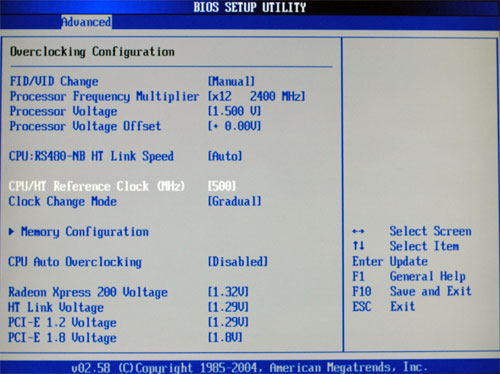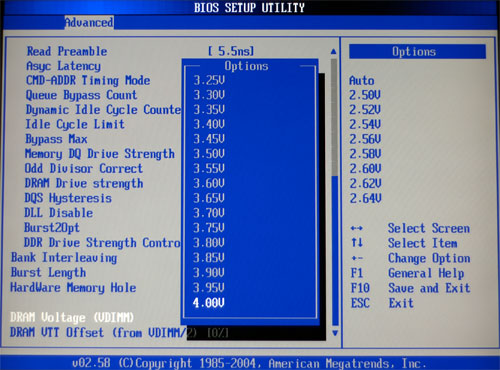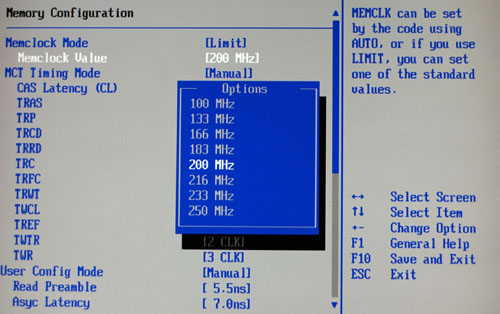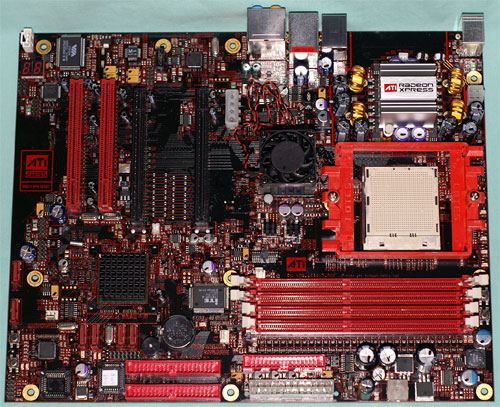ATI’s Crossfire: Best Overclocker on the Market?
by Wesley Fink on September 27, 2005 12:05 AM EST- Posted in
- CPUs
Basic Features: ATI Crossfire AMD Reference Board
It is almost heresy to call the options and adjustments on the Crossfire AMD "Basic Features", since they are clearly the best that we have ever seen on any AMD motherboard. The DFI nForce4 Ultra and SLI boards have quickly developed a reputation for offering the enthusiast every imaginable BIOS option. We mention the DFI only to put in perspective that the ATI offers 2 more memory adjustments not found on the DFI, a wider range of vDIMM to 4.0V, and even more controls to tweak the performance of the motherboard. It is clear that ATI has worked with a lot of enthusiasts in refining the Crossfire AMD - it shows in the depth and breadth of available options.
At the other end of the spectrum, ATI also offers automatic overclocking options in the BIOS for those uncomfortable with manual overclocking. You can dial in 1% to 15% overclocking and the board handles all the adjustments for you.
The ATI also has memory adjustments to DDR500 with the 4000+ Clawhammer processor that we use for standard benchmarking. The ability to run the processor at stock speed with memory at up to DDR500 opens new options for memory performance. You can do things like run the CPU at stock speed and the memory at DDR500.
Reference Boards are designed for qualification and we are certain that many would find the lack of any x1/x2 PCIe slots and just 2 PCI slots to be a concern if this were a production board. We saw a different slot arrangement on the Gigabyte ATI Crossfire AMD, and you will likely see many different slot configurations on production boards.
You may have noticed that the Gigabyte that we previewed several months ago controlled Crossfire with a "paddle board" similar to what we are accustomed to on NVIDIA. The AMD Reference Board does not use a paddle-card and all switching is done in the BIOS. In fact, the AMD Reference Board is capable of full auto-switching of single or dual video cards with no adjustments required in the BIOS if left in "Auto" mode. A number of video switching options are available to motherboard manufacturers.
| ATI Crossfire AMD Reference Board | |
| CPU Interface | Socket 939 Athlon 64 |
| Chipset | ATI RD480 Northbridge - ATI SB450 Southbridge |
| Bus Speeds | 200 to 500MHz in 1MHz Increments |
| Memory Speeds | DDR200,266,333,366,400,433,466,500 |
| PCIe Speeds | 100 to 200MHz in 1MHz increments |
| PCI/AGP | Fixed at 33/66 |
| Core Voltage | Auto, 0.825V to 1.55V in 0.025V increments PLUS .0V to 0.6V in 0.02V increments (Maximum vCore 2.15V) |
| CPU Clock Multiplier | 4x-25.5x in 0.5X increments |
| DRAM Voltage | Auto, 2.5V to 3.0V in .02V increments 3.0V to 4.0V in .05V increments (Maximun Memory Voltage 4.0V) |
| HyperTransport Frequency | 1000MHz (1GHz) |
| HyperTransport Multiplier | Auto, 1X to 5X |
| HyperTransport Voltage | 1.22V, 1.29V, 1.39V, 1.5V |
| Xpress 200 Voltage | 1.22V, 1.29V, 1.39V, 1.5V |
| PCIe 1.2 Voltage | 1.22V, 1.29 V, 1.39 V, 1.5V |
| PCIe 1.8 Voltage | 1.8V, 1.9V |
| Auto Overclocking | 1% to 15% |
| Memory Slots | Four 184-pin DDR DIMM Slots Dual-Channel Configuration Regular Unbuffered Memory to 4GB Total |
| Expansion Slots | 2 PCIe x16 2 PCI Slots |
| Onboard SATA/RAID | 4 SATA Drives by SB450 (RAID 0, 1, JBOD) 2 SATA II Drives by Sil 3231 |
| Onboard IDE/IDE RAID | Two Standard ATA133/100/66 (4 drives) |
| Onboard USB 2.0/IEEE-1394 | 8 USB 2.0 ports supported by SB450 2 1394 Firewire by VIA |
| Onboard LAN | Gigabit PCIe Ethernet by Marvel 88E8052 |
| Onboard Audio | Azalia HD Audio by Realtek ALC880 |
| BIOS | AMI Build 50 and Award Build 54 |
It is almost heresy to call the options and adjustments on the Crossfire AMD "Basic Features", since they are clearly the best that we have ever seen on any AMD motherboard. The DFI nForce4 Ultra and SLI boards have quickly developed a reputation for offering the enthusiast every imaginable BIOS option. We mention the DFI only to put in perspective that the ATI offers 2 more memory adjustments not found on the DFI, a wider range of vDIMM to 4.0V, and even more controls to tweak the performance of the motherboard. It is clear that ATI has worked with a lot of enthusiasts in refining the Crossfire AMD - it shows in the depth and breadth of available options.
At the other end of the spectrum, ATI also offers automatic overclocking options in the BIOS for those uncomfortable with manual overclocking. You can dial in 1% to 15% overclocking and the board handles all the adjustments for you.


The ATI also has memory adjustments to DDR500 with the 4000+ Clawhammer processor that we use for standard benchmarking. The ability to run the processor at stock speed with memory at up to DDR500 opens new options for memory performance. You can do things like run the CPU at stock speed and the memory at DDR500.
Reference Boards are designed for qualification and we are certain that many would find the lack of any x1/x2 PCIe slots and just 2 PCI slots to be a concern if this were a production board. We saw a different slot arrangement on the Gigabyte ATI Crossfire AMD, and you will likely see many different slot configurations on production boards.
You may have noticed that the Gigabyte that we previewed several months ago controlled Crossfire with a "paddle board" similar to what we are accustomed to on NVIDIA. The AMD Reference Board does not use a paddle-card and all switching is done in the BIOS. In fact, the AMD Reference Board is capable of full auto-switching of single or dual video cards with no adjustments required in the BIOS if left in "Auto" mode. A number of video switching options are available to motherboard manufacturers.












40 Comments
View All Comments
stromgald - Tuesday, September 27, 2005 - link
Is it just me or is there a molex connector and small fan on the reference board . . . and what exactly are they for? It looks like the north and southbridge are under the silver ATI heatsink and the black heatsink with lots of fins. I'm not sure what's under the fan and what the molex connector would be for.stromgald - Tuesday, September 27, 2005 - link
Well, I suspect its for the crossfire graphics, but I'd like some confirmation. The passive heatsinks are good, but that itty bitty fan looks noisy. It suggests that whatever's under that fan gets hotter than either the north or south bridge, then again its just a refernece board.Palek - Tuesday, September 27, 2005 - link
Actually, the silver heatsink is more likely cooling MOSFETs/voltage regulators, while the black heatsink/fan combo is probably for the N/B and the passive black heatsink for the S/B.Wesley Fink - Tuesday, September 27, 2005 - link
On the article board photo:The silver heatsink is cooling MOSFETs, the black with fan cools the Northbridge (the small fan is really very quiet), the short heatsink cools the southbridge. I also have another board with all passive heatsinks. On both boards the NB gets warm dutring extreme OC, but I did not experience any throttling or shutdown issues.
The 4-pin Molex is to power the Crossfire PCIe x16 slots.
michal1980 - Tuesday, September 27, 2005 - link
looks good, but where is it? ati must ethier be getting close to releaseing something, ortired of not really being talked about
aGreenAgent - Tuesday, September 27, 2005 - link
It's called a reference board for evaluation purposes :)Board manufacturers get to clone this for their own boards, I do believe.
ariafrost - Tuesday, September 27, 2005 - link
This looks to be one sweet chipset, hope it hits retail really soon.flexy - Tuesday, September 27, 2005 - link
i have to say that this is nice and interesting we finally have a contender in the NF4 dominated high-end mobo sector. No there's something else than always "dfi NF4" - this is nice. Competition is a good thing so are choices.I dont know, however, if it is interesting for me, eg. i am preyy ok with my dfi lanpartu....but...
Question: So...i got a X850 - and ('scuse me, i am kinda shocked !) i would need a DIFFERENT card for crossfire ("X850XT Master") because the "normal" X850XT would not work in crossfire (dual) mode????
(Not that i am interested in CF or SLI, i am just not a fan of dual gfx-card solutions. But this just caught my attention.
Regarding USB:
Well that's a shame...but then you can always get a USB pci (oe even pci-ex) card for a few bucks if you want fast and perfect USB 2.0 etc..... this is a bit bad - but then NOT a reason not to get this board. I can get a USB2.0
Btw. a USB2.0 pci-card (got a free slot, i hope so ? :) card at newegg is $5.89 + $4 s/h.....if you seriously think lack of stellar USB performance is a major downside of this board....well :)
JarredWalton - Tuesday, September 27, 2005 - link
You need two cards for Crossfire to work. One card is a Master card, and the other card is a slave card. I believe there are three Crossfire cards:
X850 XT Crossfire: $349
X800 256MB Crossfire: $299
X800 128MB Crossfire: $199
Note that I'm not positive on the prices, but the original MSRPs for R4xx Crossfire have all dropped substantially. The X850 XT CF can be used with any X850 series card, the X800 cards are the same, but you would want to get the version with the same amount of RAM as your existing GPU.
Now, here's where things are a bit tricky. At present, let's say you don't have an ATI R4xx card. If you want Crossfire for such a platform, you need to buy a regular card as well as a Crossfire card, and the CF card needs to be in the primary slot. As Wes (or Derek?) stated, you can upgrade in stages if you want by purchasing the CF card first. To my knowledge, you cannot use two CF cards together - I could be wrong on this, but I think you want one card to *not* have the compositing chip and DMS port.
Hope that answers your question.
anandtechrocks - Tuesday, September 27, 2005 - link
I agree, this board looks amazing! Might be time to sell the DFI NF4 Ultra-D. I really like how the voltages are in decimal increments instead of the precentages like in my Ultra-D.